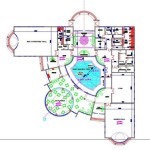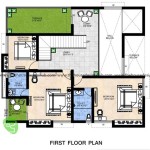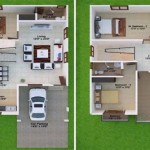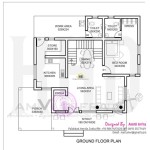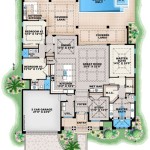House Plan With Garage Underneath: Maximizing Space and Functionality
The house plan with a garage underneath, also known as a basement garage or tuck-under garage, represents a unique and practical approach to residential design, particularly beneficial for properties with limited land area, challenging topography, or a desire to maximize living space above. This architectural style integrates the garage directly beneath the main living areas of the house, effectively doubling the use of the footprint. The design considerations extend beyond mere space-saving, influencing the structural engineering, aesthetic appeal, and overall value of the property. This article delves into the various aspects of house plans featuring garages underneath, exploring their advantages, design considerations, and potential challenges.
The primary driver behind choosing a house plan with a garage underneath stems from the need to optimize the use of available land. In urban areas, suburban communities with smaller lot sizes, or properties situated on sloped terrains, traditional detached garages or side-entry garages may not be feasible or desirable. By positioning the garage underneath the house, the homeowner gains valuable space above for living areas, gardens, patios, or other outdoor amenities. This design solution effectively unlocks the full potential of the building site, allowing for a more spacious and functional living environment. Furthermore, incorporating the garage directly into the house's foundation can reduce the overall construction cost compared to building a separate garage structure.
Advantages of Garage-Underneath House Plans
The benefits of integrating a garage beneath the house extend beyond space efficiency. Security, convenience, and energy efficiency are among the key advantages that make this design a compelling choice for many homeowners.
Firstly, security is significantly enhanced. Direct access from the garage to the house eliminates the need to walk outdoors, especially during inclement weather or at night. This provides a secure and convenient entry point, reducing the risk of exposure to theft or other security threats. Homeowners can move directly from their vehicles into the house without stepping outside, adding a layer of personal safety and peace of mind.
Secondly, convenience is a significant selling point. Carrying groceries, luggage, or other items from the car into the house is simplified, particularly beneficial for individuals with mobility limitations or families with young children. The direct access eliminates the need to navigate external stairs or pathways, making everyday tasks more manageable and convenient. In areas with harsh weather conditions, the ability to park the car indoors and enter the house directly is a significant advantage.
Thirdly, energy efficiency can be improved. With the garage situated beneath the living areas, it provides an additional layer of insulation, helping to regulate temperature and reduce energy consumption. The earth surrounding the garage walls acts as a natural insulator, moderating temperature fluctuations within the garage and the rooms above. This can lead to lower heating and cooling costs, contributing to a more sustainable and energy-efficient home. However, proper insulation and ventilation are crucial to prevent moisture buildup and maintain air quality.
Finally, property value can be positively influenced. A well-designed house with a garage underneath can be a desirable feature, particularly in areas where space is at a premium or where the terrain presents challenges for traditional garage placement. The added convenience and security features, along with the efficient use of space, can increase the overall market appeal and value of the property. However, careful planning and professional execution are essential to ensure that the garage is structurally sound and aesthetically integrated with the rest of the house.
Design Considerations for Garage-Underneath House Plans
Designing a house plan with a garage underneath requires careful consideration of various factors, including structural engineering, drainage, ventilation, and accessibility. Addressing these aspects effectively is crucial for ensuring the long-term durability, functionality, and safety of the structure.
Structural integrity is paramount. The house's foundation and supporting walls must be designed to withstand the weight of the entire structure, including the garage and the living areas above. Reinforced concrete is often used for the foundation walls and floor, providing the necessary strength and stability. Proper engineering calculations are essential to ensure that the foundation can support the load and resist soil pressure. The design must also comply with local building codes and regulations.
Drainage is another critical factor. Effective drainage systems are necessary to prevent water from accumulating around the foundation and seeping into the garage. This includes proper grading around the house, installation of perimeter drains, and ensuring that the garage floor is sloped slightly to allow water to drain away. Sump pumps may be required in areas with high water tables to remove excess water and prevent flooding. Regular maintenance of the drainage system is essential to prevent clogs and ensure its continued effectiveness. The placement of downspouts and gutters should be carefully planned to direct water away from the foundation.
Ventilation is vital to prevent the buildup of moisture, fumes, and odors in the garage. Proper ventilation can be achieved through a combination of natural and mechanical methods. Natural ventilation involves the use of vents or windows to allow air to circulate freely. Mechanical ventilation systems, such as exhaust fans, can be used to remove pollutants and maintain air quality. Carbon monoxide detectors should be installed in the garage and adjacent living areas to alert occupants of dangerous levels of this odorless, colorless gas. Regular inspection and maintenance of the ventilation system are necessary to ensure its proper functioning.
Accessibility is crucial for ensuring that the garage is easy to use and navigate. The driveway leading to the garage should be properly graded and constructed to provide a smooth and safe access point. The garage door should be wide enough to accommodate vehicles comfortably and equipped with an automatic opener for convenience. Interior stairs leading from the garage to the house should be well-lit and equipped with handrails for safety. Consider the needs of individuals with mobility limitations when designing the accessibility features of the garage. Ramps or lifts may be necessary to provide access for wheelchair users.
Potential Challenges of Garage-Underneath House Plans
While house plans with garages underneath offer numerous advantages, they also present potential challenges that must be addressed during the design and construction phases. These challenges include moisture management, noise transmission, and design limitations.
Moisture management is a significant concern. Garages located underground are prone to moisture buildup due to the surrounding soil and the potential for water leaks. This can lead to mold growth, corrosion, and damage to stored items. Proper waterproofing of the foundation walls and floor is essential to prevent moisture from seeping into the garage. This includes applying a waterproof membrane to the exterior of the foundation walls and ensuring that all joints and seams are properly sealed. Regular inspections should be conducted to identify and address any signs of moisture intrusion. Installing a dehumidifier can help to control humidity levels and prevent mold growth.
Noise transmission can be an issue. The sound of cars entering and exiting the garage, as well as garage door operation, can be transmitted to the living areas above, potentially disrupting residents. Proper soundproofing measures can mitigate this issue. This includes using sound-absorbing materials in the garage ceiling and walls, installing a quiet garage door opener, and ensuring that the garage door is properly insulated. Vibration dampers can be used to reduce the transmission of vibrations from the garage to the house. Consider the placement of bedrooms and other noise-sensitive areas when designing the floor plan to minimize the impact of garage noise.
Design limitations may be encountered. Integrating a garage underneath the house can present challenges in terms of floor plan layout and ceiling height. The garage must be large enough to accommodate vehicles and storage needs, which can impact the size and shape of the rooms above. Ceiling height in the garage must be sufficient to allow for comfortable vehicle access and movement. The design must also consider the placement of stairs leading from the garage to the house, ensuring that they are conveniently located and do not obstruct the flow of traffic. Working with an experienced architect and engineer is essential to overcome these design limitations and create a functional and aesthetically pleasing house plan.
Furthermore, the cost of construction can be higher for a house with a garage underneath compared to a traditional house with a detached garage. The excavation and foundation work required for an underground garage can be more complex and expensive. However, the added convenience, security, and space efficiency may justify the higher cost for some homeowners. A detailed cost analysis should be conducted before making a decision to build a house with a garage underneath. This analysis should consider the cost of excavation, foundation construction, waterproofing, ventilation, and other related expenses.

Hillside House Plans With Garages Underneath Houseplans Blog Com

Plan 41305 Hillside Modern House With Drive Under Garage

Hillside House Plans With Garages Underneath Houseplans Blog Com

4 Bed Garage Underneath 220 N Dream Home Upward Sloping Block House Designs Plans Country Style Affordable

4 Bedroom Contemporary Drive Under Style House Plan 4742

3 Bedroom Split Level House Plan With Drive Under Garage

Beautiful Multi Generational Farm House Style Plan 1104 Gardenia

Plan 69649am Northwest House With Drive Under Garage Sloping Lot Plans

Plan 062g 0184 The House

Hillside House Plans With Garages Underneath Houseplans Blog Com


